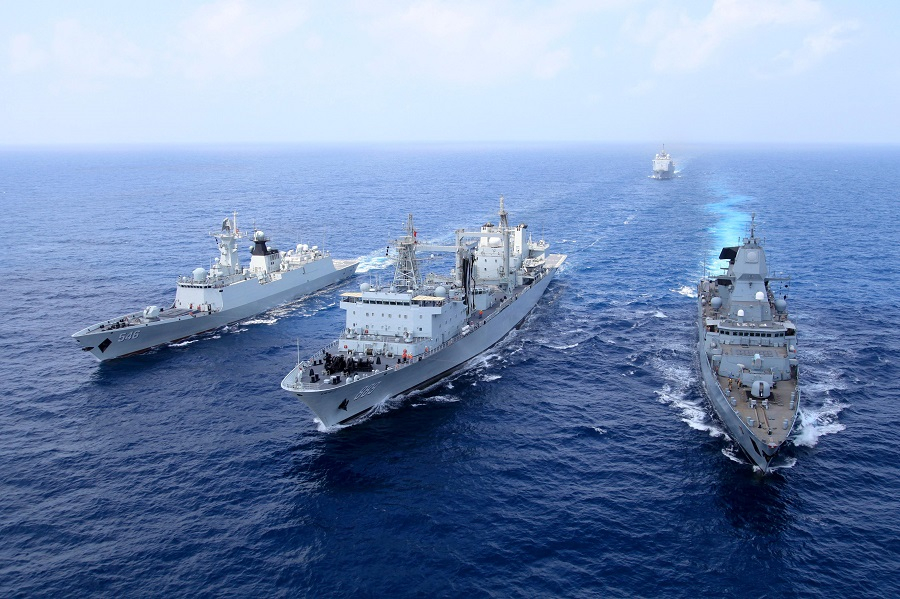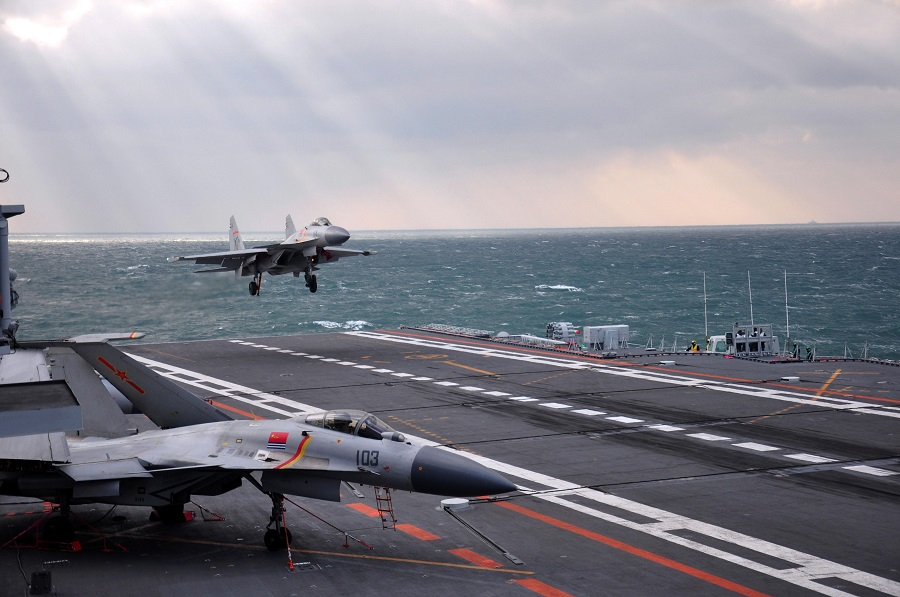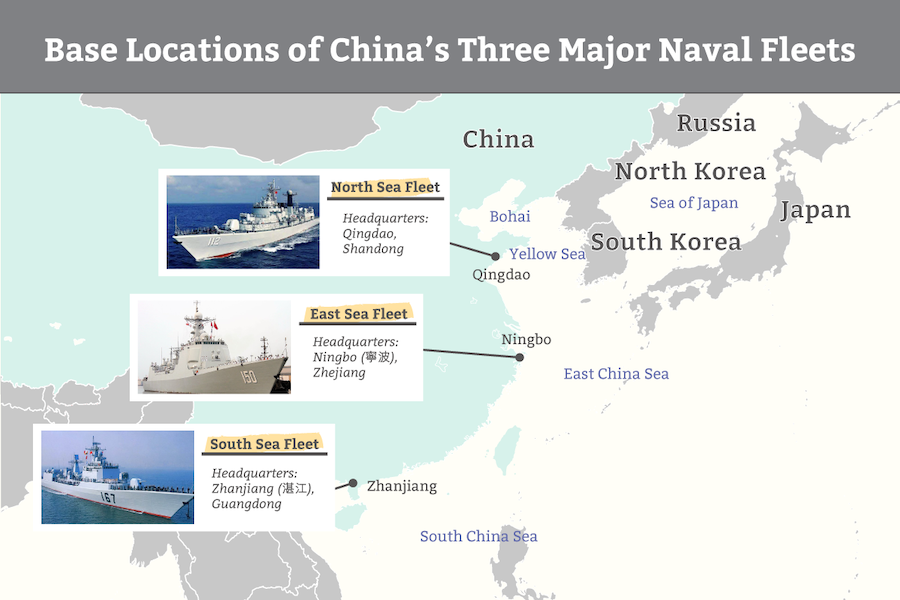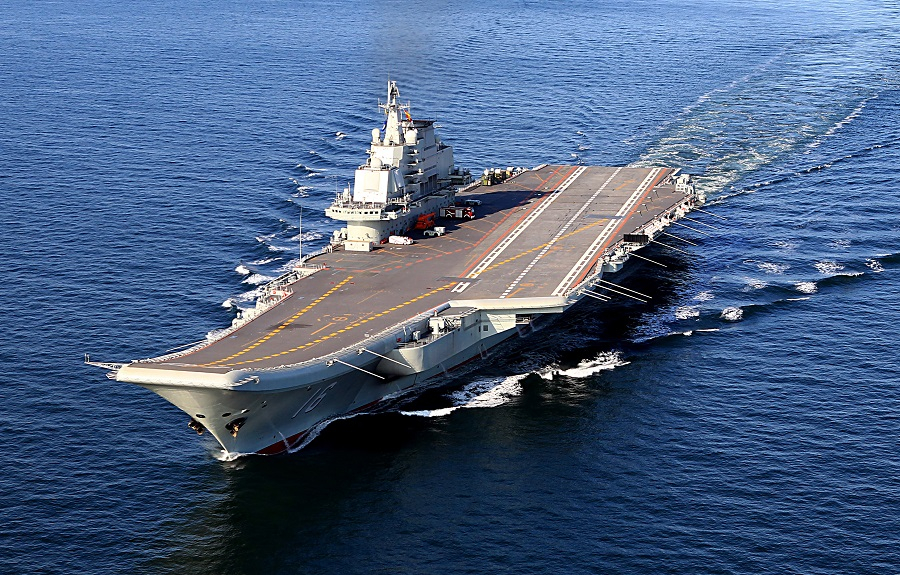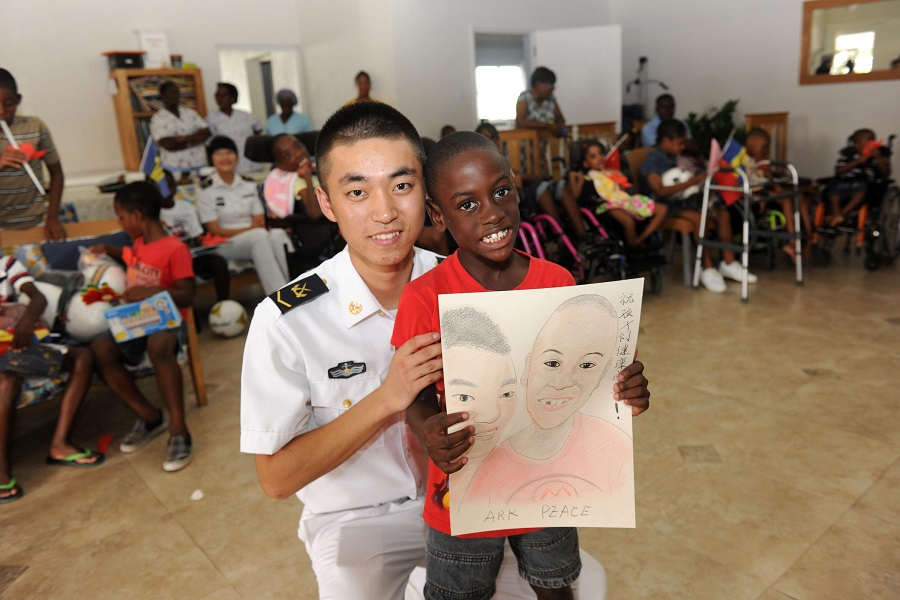This year marks the 70th anniversary of the founding of the People’s Liberation Army Navy, a modernized force that has attracted worldwide attention in recent years. Here, we will learn about this defender of the seas by exploring its branches, how its armament has evolved over the years, and the non-combat duties performed for the international community.
"This is the Chinese naval escort taskforce. Please call me on Channel 16 if you need help.”
Aired in Chinese and English, the announcement is a familiar one to Chinese and foreign merchant ships sailing through the Gulf of Aden and waters off the Somali coast. Whenever a merchant ship, Chinese or foreign, sounds an SOS in the Gulf of Aden, the Chinese naval escort taskforce race to its rescue and protection.
“The escort in the Gulf of Aden provided by the Chinese naval task force is a strong support in cracking down [on] Somali piracies [sic] for the international community.” So said Ban Ki-moon, former secretary-general of the United Nations who hailed China’s contribution to escort missions saying “it reflects China's important role in international affairs.”
It has been 70 years since the founding of the People’s Liberation Army Navy (PLAN). Over the years, it has grown from an ill-equipped coastal defense force to a major naval power tasked with defending China’s national interests and safeguarding world peace. How did this sea change come about?
The birth of a naval power
For a long time, ground forces had served as the dominant unit of the PLA. This was also the case for the Eighth Route Army (八路軍) and the Chinese Red Army that preceded the PLA. The lack of a strong navy was keenly felt during the latter part of the Chinese Civil War. The Kuomintang navy bombarded the PLA’s bases at Tashan (塔山) during the Liaoning-Shenyang campaign (遼瀋戰役) in an attempt to break the PLA’s siege of Jinzhou (錦州). This attack inflicted devastating casualties on the PLA. Also, despite the PLA’s ultimate success in taking Shenyang, the Kuomintang forces managed to slip away with the aid of their navy; yet another challenge for which the navy-less PLA had no answer.
This remained the case until 1949, when numerous units of the Kuomintang navy defected to the PLA. These newly acquired troops and vessels needed to be integrated into the PLA. They would, sooner or later, partake in naval battles and island landings in PLA campaigns. Thus it was decided that the PLA should have its own navy. This led to the formation of the East China Military Region Navy (華東軍區海軍) in the township of Bai’ma’miao (白馬廟鄉) in Taizhou (泰州) Jiangsu province on April 23, 1949, designated as the foundation day of the PLA Navy. In December that year, the Guangdong Military Region (廣東軍區) also established its own River Defense Headquarters (江防司令部) which later joined the Zhongnan Military Region (中南軍區).
After the founding of People’s Republic of China, the Central Military Commission began to establish a central command body for its navy. On January 12, 1950, Xiao Jingguang (蕭勁光) was appointed as commander of PLAN; in April that same year, an official command structure for the navy was established, marking the navy’s formal incorporation into the PLA as one of its service branches.
The newly established navy soon proved its proficiency in several battles with Kuomintang forces: from May to August 1950, the River Defense Force of the Guangdong Military Region partook in the Wanshan Archipelago Campaign (萬山群島戰役). This was the PLA's first combined army and naval landing operation, which ended in victory for the PLA; and in January 1955, the East China Military Region’s forces launched an offense against Yijiangshan Island (一江山島) off Zhejiang province, an operation involving the PLA’s land, sea and air forces that was also a first for the PLA. They were triumphant - capturing the island within two days.
Over time, the navy grew steadily. At a conference on building the navy held in Beijing in August 1950, it was decided that the PLAN should comprise surface forces, submarine forces, naval air forces, coastal defense forces and marine corps forces. Based on principles developed at the meeting, the PLA established a coastal artillery battalion and a naval air force in 1950 and 1952 respectively. An independent submarine fleet and marine corps division were formed in 1954. Within just a few years, these successive new additions, along with the existing fleet, became the PLAN’s five major branches constituting a complete combat system that would be further refined over time.
As PLAN’s strategic role in national defense became more prominent, there was a need to standardize the military organization of regional naval forces so that they could train and fight as a body. In October 1955, the East China Military Region Navy was designated as the East Sea Fleet (東海艦隊) and the Zhongnan Military Region Navy was renamed the South China Sea Fleet (南海艦隊). In August 1960, a North Sea Fleet (北海艦隊) was established with the forces from an existing naval base at Qingdao (青島). The establishment of these three major fleets marked the completion of PLAN’s reorganization, and the three-fleet system remained the basis of PLAN’s military framework throughout numerous adjustments and reforms in the years to come.
From junks to aircraft carriers
As you would expect, PLAN’s major combat assets are its ships: they include warships, amphibious warfare ships, auxiliary vessels as well as a variety of aircraft (including carrier-based aircraft) and naval weaponry like missiles, torpedoes, artillery and electronic warfare equipment. Over the years, China’s naval armament has evolved from a mishmash of imports to one dominated by Soviet models, and finally into today’s mostly Made in China collection.
At the beginning, China’s naval armament was acquired from countries far and wide in ways that were just as diverse. Some were seized and appropriated from enemies, others were gifted but worn-out vessels that had to be repaired or retrofitted, and the rest were imported from foreign countries. Although technologically crude, overall, they fulfilled the basic objective of outfitting the navy. For instance, the PLA seized control of 30 coastal naval bases, their related equipment and nearly 100 naval vessels from the Kuomintang. The ensemble was completed with the purchase of a dozen additional ships from Hong Kong and Macau.
In the 1950s, the Sino-Soviet Treaty of Mutual Assistance enabled China to purchase a fleet of combat vessels, various types of aircraft , artillery and torpedoes from the Soviet Union. The Soviet Union also freely shared with China the vessels’ technical plans and working drawings as well as technical documents on mine production and artillery capacity and installation. Among the Soviet vessels purchased in 1954 were the destroyers Anshan (鞍山號), Fushun (撫順號), Changchun (長春號) and Taiyuan (太原號). These became the mainstays of PLAN, and were nicknamed the “Four Great Guardian Gods.” With the Soviet Union’s assistance, China started its own shipbuilding industry to construct naval vessels modeled after those of the Soviet Union. Gradually, PLAN was able to standardize its armament and replace its previous motley collection with armament that uniformly conformed to the Soviet-style.
From the mid-1950s to the mid-1960s, new China entered its first peak period in naval shipbuilding. During this period its armament transitioned from the Soviet-style to one developed by China. Since the beginning of the period of reform and opening-up, the naval armament manufacturing industry has moved rapidly towards the application of advanced technology and information technology. The Type 053H2G frigate developed in the 1990s, for example, is equipped with HHQ-7 surface-to-air missile launchers. Compared with previous models, HHQ-7 possesses enhanced firepower against aerial threats, and is more balanced in terms of its offensive and defensive capabilities.
As the 21st century unfolds, in keeping with the latest trends in military development and the practical needs of modern naval warfare, China has stepped up efforts to bolster PLAN’s air-sea capability by developing the latest armament designed for near-sea battles and far-sea defensive operations. The Type 052C anti-air guided missile destroyer and the Type 052D guided missile destroyer, constructed by Jiangnan Shipyard (江南造船廠) are China’s first naval ships equipped with phased array radar, which boasts faster detection speed, higher accuracy, and enhanced tracking capability compared with conventional radar systems. Given their capabilities, they are praised as the “Chinese Aegis (中華神盾).” They are also the first ships to feature a vertical missile launching system. In September 2012, China’s first aircraft carrier, the Liaoning (遼寧號) was commissioned, raising PLAN’s maritime capability to a new level; this was followed by China’s 2017 launch of the Type 055 destroyer, a next-generation, domestically-developed 10,000-ton-class destroyer, marking the introduction of a new generation of world-class, multi-functional large destroyers to the naval fleet. The same year also saw the official launch of China’s first domestically built aircraft carrier.
Building an ocean-going fleet
In May 2015, China released a White Paper entitled China’s Military Strategy (中國的軍事戰略). The White Paper states that “The seas and oceans bear on the enduring peace, lasting stability and sustainable development of China. The traditional mentality that land outweighs sea must be abandoned, and great importance has to be attached to managing the seas and oceans and protecting maritime rights and interests.”
Also according to this document, “In line with the strategic requirement of offshore waters defense and open seas protection, the PLA Navy (PLAN) will gradually shift its focus from ‘offshore waters defense’ to the combination of ‘offshore waters defense’ with ‘open seas protection,’ and build a combined, multi-functional and efficient marine combat force structure.”
Maritime rights play an important role in national trade and development. For the majority of its history, China was preoccupied with defending its land rights, and was not concerned about its maritime rights. With a weak economy and lacking national strength in its early years, the People’s Republic of China had started out pursuing a policy of “coastal defense.” Now as a stronger nation, China can claim its rightful share of marine resources as well as promote maritime trade by asserting its maritime rights.
Another aspect to be considered is command of the sea, which has a particularly salient role in national defense. As sovereignty disputes over some of China’s coastal waters and islands have yet to be settled, the possession of a mighty navy is crucial for safeguarding the nation’s national security and asserting sovereignty over its maritime territories. As China’s maritime awareness rises, China’s navy must also enhance its ocean-going capabilities and transform from a “brown-water navy” that is only capable of coastal defense to a “blue-water navy” capable of traversing the high seas and engaging in operations globally. This will allow China to play a more active role in safeguarding the nation’s maritime rights. For China, the commissioning of Liaoning signifies the beginning of PLAN’s ocean-going age.
This newly developed capability does more than just repel marine invasions and maintain peace in China’s waters. According to the British scholar Ken Booth, navies fulfill their nations’ objectives in three areas -- military, diplomatic and policing. By doing so they demonstrate their power and presence. In China’s case, a strong navy can participate in and support China’s diplomatic activities, prevent and combat maritime crime, and maintain order on the seas.
Diplomatic activities such as the exchange of visits between naval vessels, round-the-world trips, offshore training and joint military exercises all help demonstrate naval capabilities as well as promote understanding between the navies of different countries. In 2016, China’s naval taskforce attended the Rim of the Pacific Exercise, a multinational naval exercise held in the west Pacific Ocean, and participated in drills in artillery firing, humanitarian aid operations, formation maneuvering and other tasks alongside United States’ naval vessels. The outstanding performance of the Chinese taskforce helped foster its international reputation and improve communication and trust between the Chinese and U.S. navies.
The navy fulfills its policing duties by escorting ships on the open sea, performing rescues, providing disaster relief, and helping to protect and evacuate compatriots. In 2008, in support of the United Nation’s call for action to combat piracy, China began dispatching naval taskforces to the distant Gulf of Aden and the seas surrounding Somalia to perform escort missions. Within a decade, PLAN contributed a total of 31 taskforces to this effort and convoyed 1191 batches of a total of 6595 Chinese and foreign vessels. The Chinese taskforce has also rescued, escorted and assisted more than 60 ships in distress, achieving a 100-percent safety record for both the convoyed vessels and the taskforce itself. They also evacuated Chinese civilians from Libya and Yemen with great success, and took part in the search and rescue operation for the missing Malaysian Airlines civilian aircraft. Operation Red Sea (紅海行動) a blockbuster movie, was based on PLAN’s evacuation of Chinese citizens from Yemen.
Over the past 70 years, the Chinese navy has experienced many trials and tribulations through which has emerged stronger. It has generated international goodwill by showing the world it is willing to take responsibility as a leading nation. By putting ‘its money where its mouth is’ through its actions China has earned its name on the world stage. Nevertheless, as PLAN continues to venture into the blue waters of the high seas, its original goal - to protect China and safeguard its peace - remains its guiding star.
References:
The People’s Navy Sails Forth - Legends of the People’s Liberation Army Navy (「人民海軍向前進」——中國人民解放軍海軍傳奇) by Han Hongquan (韓洪泉) Extensive Collection of the Party History (黨史博采) 2017 Issue 2
The Navy's Diplomacy of Great Powers with Chinese Characteristics:From the Perspective of Contemporary Sea Power (中國特色的大國海軍外交——基於當代海權思想的視角) by Yang Zhen (楊震) Cai Liang (蔡亮), Journal of Social Sciences (社會科學), 2016 Issue 12
Towards the Deep Blue - The Chinese Navy’s Development as Viewed from the Maritime Rights Theory Perspective (走向深藍——海權論視角下中國海軍的前進方向) by Wei Qiaofang (韋巧芳) Wang Guoliang (王國梁) Business (商) 2016 Issue 17
The Chinese Navy Throughout 40 Years of Reform and Opening-Up: A Retrospect of the Development of Naval Armament (改革開放40年中國海軍 武器裝備建設回顧) by Li Wen (立文) China Economic & Trade Herald (中國經貿導刊) January 2019 Volume 1




